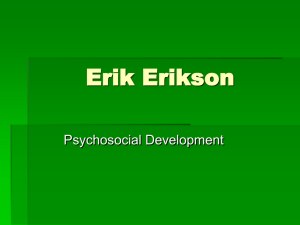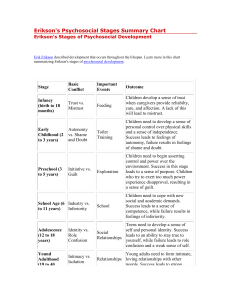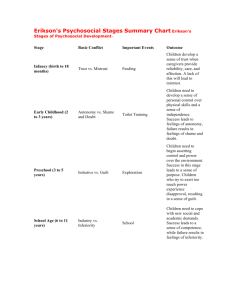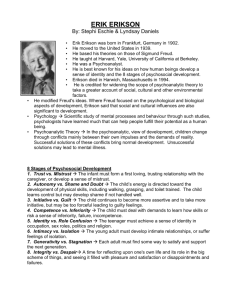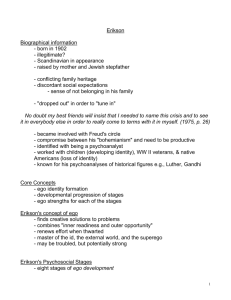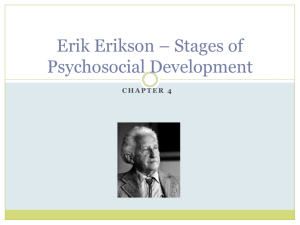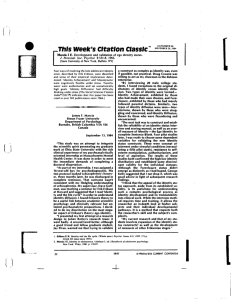Erikson's Theory of Psychosocial Development
advertisement
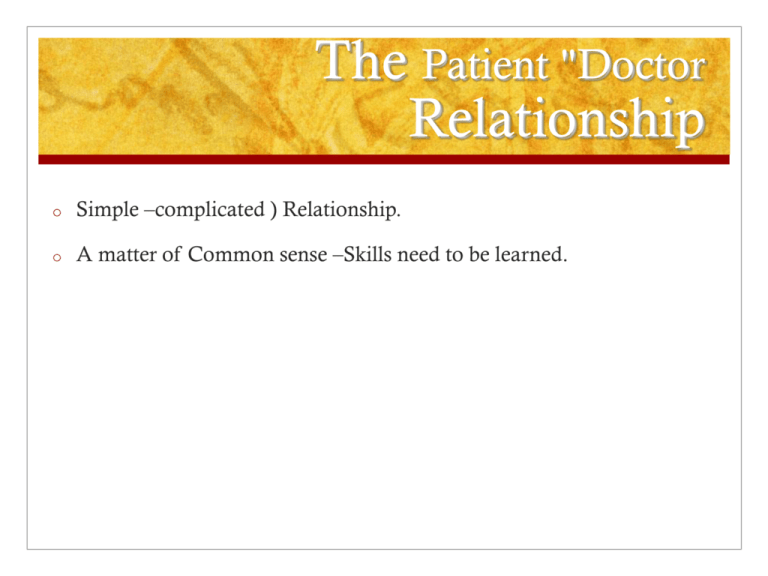
The Patient "Doctor Relationship o Simple –complicated ) Relationship. o A matter of Common sense –Skills need to be learned. The Patient "Doctor Relationship techniques of talking and listening to people. To diagnose, manage, and treat an ill person, doctors and therapists must learn to listen. They need the skills of active listening, which means listening both to what they and the patient are saying and to the undercurrents of the unspoken feelings between them An effective relationship is characterized by good rapport Rapport is the spontaneous, conscious feeling of harmonious responsiveness that promotes the development of a constructive therapeutic alliance. It implies an understanding and trust between the doctor and the patient. Frequently, the doctor is the only person to whom the patients can talk about things that they cannot tell anyone else. Most patients trust their doctors to keep secrets, and this confidence must not be betrayed. Establishing Rapport putting patients and interviewers at ease; finding patients' pain and expressing compassion; evaluating patients' insight and becoming an ally; showing expertise; establishing authority as physicians and therapists; balancing the roles of empathic listener, expert, and authority. Empathy To put oneself in another person's place. Sympathy: Feeling sorry. Biomedical model: approach to pt care in which only the biological and medical aspects of apt illness are considered. Biopsychosocial model: Comprehensive approach. Transference: The pt are transferring feelings toward others in their life onto the physician. Counter-transference: Emotional reactions to the pt from the doc that often involve the doctor past experience. Physician styles: The paternalistic style. The shared decision making style. The consumer based style Professional Boundaries Difficult Doctor-Patient :Relationships The Seductive Patient The “Hateful” Patient The Patient With a Thousand Symptoms The Patient in the Hospital Setting The Mentally Disturbed Patient The Dying Patient Correct diagnosis and treatment is only half the way Factors that impede compliance: Low level of distress Denial of illness Poor communication Complex regimens Treatment that is embarrassing Pts perception Side effects Factors that enhance compliance Rapport Simple regimen Increased level of distress Waiting room time Increased time with doc Family support Erikson's Theory of Psychosocial Development ; What is Psychosocial Development? Erik Erikson’s theory of psychosocial development is one of the bestknown theories of personality in psychology. Much like Sigmund Freud, Erikson believed that personality develops in a series of stages. Unlike Freud’s theory of psychosexual stages, Erikson’s theory describes the impact of social experience across the whole lifespan. One of the main elements of Erikson’s psychosocial stage theory is the development of ego identity. Ego identity is the conscious sense of self that we develop through social interaction. According to Erikson, our ego identity is constantly changing due to new experience and information we acquire in our daily interactions with others. In addition to ego identity, Erikson also believed that a sense of competence also motivates behaviors and actions. Each stage in Erikson’s theory is concerned with becoming competent in an area of life. If the stage is handled well, the person will feel a sense of mastery, which he sometimes referred to as ego strength or ego quality If the stage is managed poorly, the person will emerge with a sense of inadequacy. stage Basic Conflict Important Events Outcome Erikson's Psychosocial Stages Summary Chart Stage-1 -infancy birth to 18 months) Trust vs. mistrust Feeding Children develop a sense of trust when caregivers provide reliabilty, care, and affection. A lack of this will lead to mistrust. Stage-2 Early Childhood Autonomy vs. Shame and (2 to 3 years) Doubt Toilet Training Children need to develop a sense of personal control over physical skills and a sense of independence. Success leads to feelings of autonomy, failure results in feelings of shame and doubt. Stage-3 Preschool (3 to 5 years) Initiative vs. Exploration Guilt Children need to begin asserting control and power over the environment. Success in this stage leads to a sense of purpose. Children who try to exert too much power experience disapproval, resulting in a sense of guilt. Stage-4 School Age (6 to 11 years) Industry vs. Inferiority School Children need to cope with new social and academic demands. Success leads to a sense of competence, while failure results in feelings of inferiority. Stage-5 Adolescenc e (12 to 18 years) Identity vs. Social Relationships Role Confusion Teens needs to develop a sense of self and personal identity. Success leads to an ability to stay true to yourself, while failure leads to role confusion and a weak sense of self. Stage-6 young Adulthood (19 to 40 years intimacy vs. isolation Young adults need to form intimate, loving relationshi relationships with other ps people. Success leads to strong relationships, while failure results in loneliness and isolation. Stage-7 Middle Generativity Adulthood vs. (40 to 65 Stagnation years) Adults need to create or nurture things that will outlast them, often by having Work and Parenthood children or creating a positive change that benefits other people. Success leads to feelings of usefulness and accomplishment, while failure results in shallow involvement in the world. Stage-8 Maturity(65 to death) Ego Integrity vs. Despair Reflection on Life Older adults need to look back on life and feel a sense of fulfillment. Success at this stage leads to feelings of wisdom, while failure results in regret, bitterness, and despair.
